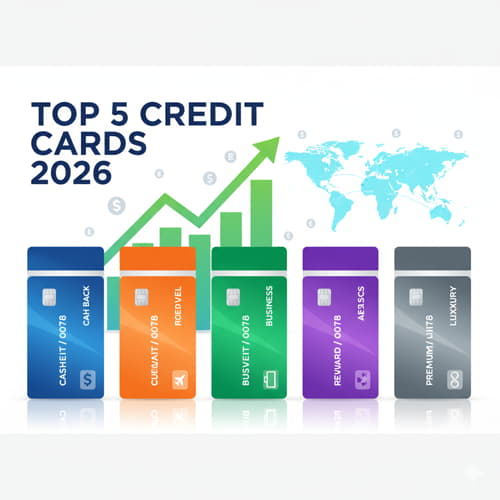Best Credit Cards 2026: Top 5 Picks for Max Rewards & Low APR
Best Credit Cards 2026: Top 5 Picks for Max Rewards & Low APR
After navigating the turbulent waters of high inflation and rising interest rates in 2025, choosing a smart credit card in 2026 is more critical than ever. A credit card isn’t just a tool for emergencies; it’s a powerful financial instrument that can help you earn rewards, manage debt, and significantly improve your quality of life.
But with so many options flooding the market, how do you find the best one? A card with fantastic cashback might have a soaring APR (Annual Percentage Rate). Conversely, a card with low interest might offer lackluster rewards.
This post is designed to eliminate that confusion. As financial experts at Smart Loan Solutions & Credit Card Tips, we have analyzed the 2026 American consumer trends and spending habits to select the Top 5 Credit Cards. This guide will not only help you choose the best card but also prepare you to be a smart and successful borrower before you even apply.
 ## The Core 5: Our Best Credit Cards for 2026
## The Core 5: Our Best Credit Cards for 2026
We’ve selected these five cards based on the key financial goals of US consumers in the upcoming year:
### Pick 1: The Ultimate Cash Back Hero (For Everyday Spenders)
If your primary goal is to maximize savings on daily purchases, a flat-rate cashback card is unbeatable. We are highlighting a card here that reliably offers 2% or more cashback on all purchases, with no rotating categories to track.
- Expert Analysis: These cards are ideal for users who pay their balances in full every month (thus avoiding APR) and frequently spend on groceries, gas, and utilities. Ensure the cashback can be easily redeemed as a statement credit.
### Pick 2: The Travel Rewards Champion (For Frequent Flyers)
For those who spend heavily on airfare, hotels, and dining, a dedicated travel rewards card is a must. With annual fees being adjusted in 2026, we’ve focused on a card whose fee is easily offset by its benefits (like annual travel credits).
- Key Feature: The welcome bonus on this card should cover the cost of a domestic flight or a few nights’ hotel stay. Its premium perks, such as complimentary airport lounge access or travel insurance, are invaluable for a frequent flyer’s peace of mind.
### Pick 3: The 0% APR Debt Destroyer (For Balance Transfers)
If you carry high-interest debt on another credit card, your immediate goal should be to pay it down quickly. A 0% APR balance transfer card is the perfect mechanism. These cards typically offer an introductory period of 12 to 21 months with zero interest.
- Our Advice: The crucial rule here is to pay off the entire transferred balance before the promotional APR period ends. This card should be used as a debt elimination tool, not an excuse to spend more.
### Pick 4: Best for Building Credit (Starter Card)
For individuals with low or no credit history (especially young Americans), an entry-level secured card is the safest starting point. This requires a security deposit, which serves as your credit limit.
- Vital Information: The main benefit of this card is that it reliably reports your activity to the major credit bureaus. By making small purchases and paying them on time, you can often transition to an unsecured card with a higher limit within a year.
### Pick 5: Best for Small Businesses (Business Rewards)
Designed for entrepreneurs, this category of cards offers high rewards rates on business expenses like office supplies, software subscriptions, or client entertainment. It also helps you keep personal and business finances strictly separate.
- Personal Experience: Always separate your spending. This simplifies tax filing tremendously and gives you a clearer, professional overview of your business’s financial health.
## How We Chose the “Best” for 2026: Our Expert Methodology
The world of credit cards is complex and often misleading. When selecting these five cards, we looked beyond just the rewards rate and adopted a holistic approach necessary for a smart US consumer:
- APR vs. Rewards vs. Fees: We calculated the Net Annual Value. If a card has a $95 annual fee, the rewards and benefits should easily exceed $200 in value to be worth it. Our analysis prioritizes rewards cards primarily for users who always pay their balance in full.
- Flexibility and Redemption: Rewards should be easy to redeem at a fair value. We avoided cards where points are difficult to use or are worth pennies on the dollar.
- Credit Score Range: We ensured our selections cover a spectrum of credit scores—from those with excellent credit down to those just starting their journey.
- Support and Insurance: In 2026, essential perks like reliable customer service, travel insurance, and purchase protection are non-negotiable features we sought out.
## 3 Crucial Mistakes to Avoid When Applying (Your Next Steps)
You’ve chosen the best card. Now, it’s time to apply. But before rushing the process, avoid the three most common pitfalls we see in our field:
- Not Checking Your Credit Score: Applying for a premium card with a low score will likely lead to rejection, and the resulting hard inquiry will slightly ding your score. Know your score first. [Place high-authority link to a credit bureau/report site here]
- Applying for Too Many Cards: Multiple applications (hard inquiries) within a short timeframe (e.g., one month) severely hurt your score. Focus your effort on one or two top choices.
- Chasing Only the Sign-up Bonus: While initial bonuses are attractive, the card’s long-term value—its APR, fees, and rewards structure—must match your sustained spending habits.
## FAQs About 2026 Credit Cards
Q: Can I get a travel rewards card with a low credit score? A: Generally, no. The best travel rewards cards require a ‘Good’ to ‘Excellent’ credit score (700+). If your score is low, focus on building it up first with a secured or starter card.
Q: Is the credit card APR expected to rise further in 2026? A: While dependent on Federal Reserve policy, experts predict a potential stabilization or slight decrease in the latter half of 2026. However, since card APRs are inherently variable, we emphasize using the 0% intro period to eliminate debt.
Q: Is the best card always the one with the highest annual fee? A: Absolutely not. A card with a $550 fee may be unsuitable for you. The best card is the one whose rewards and benefits are worth at least three times its annual fee, based on your specific spending habits.
 ## The Core 5: Our
## The Core 5: Our 

